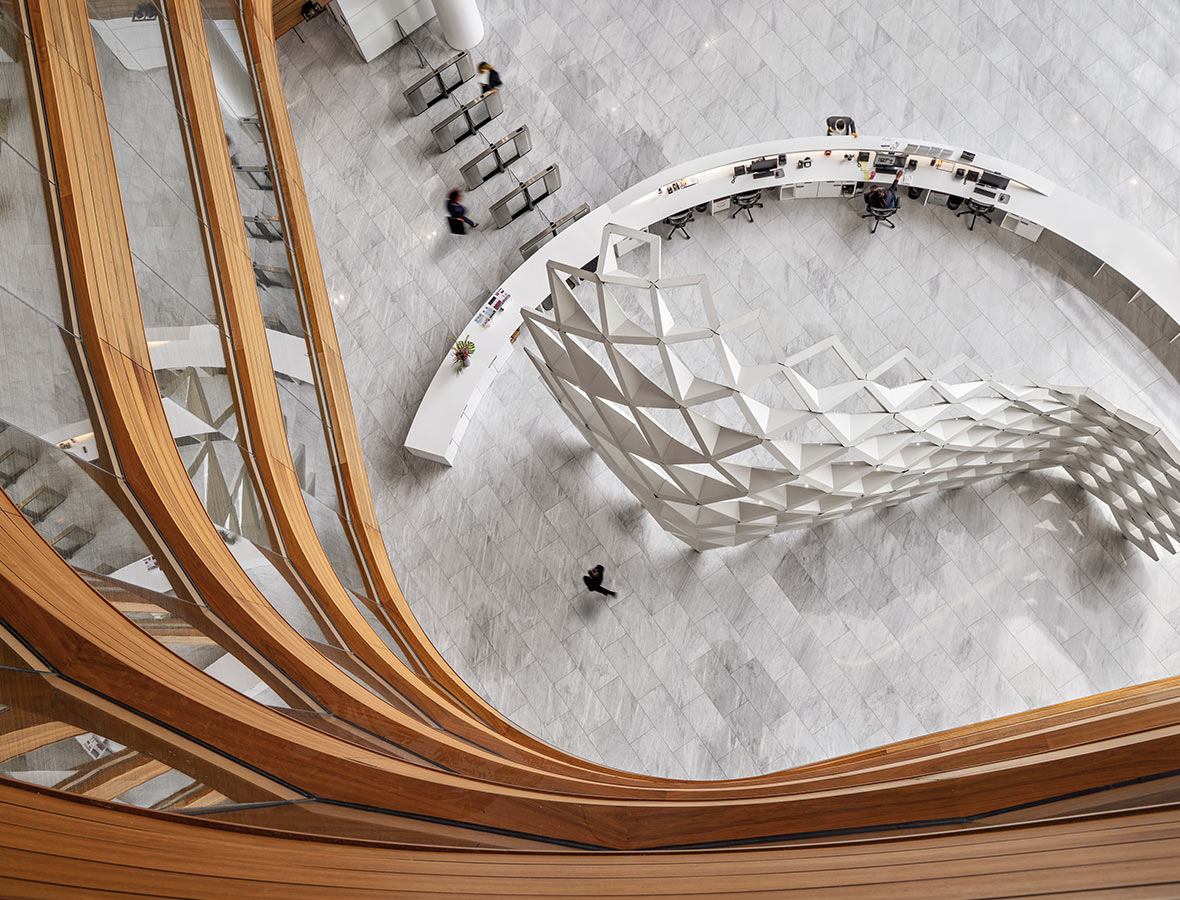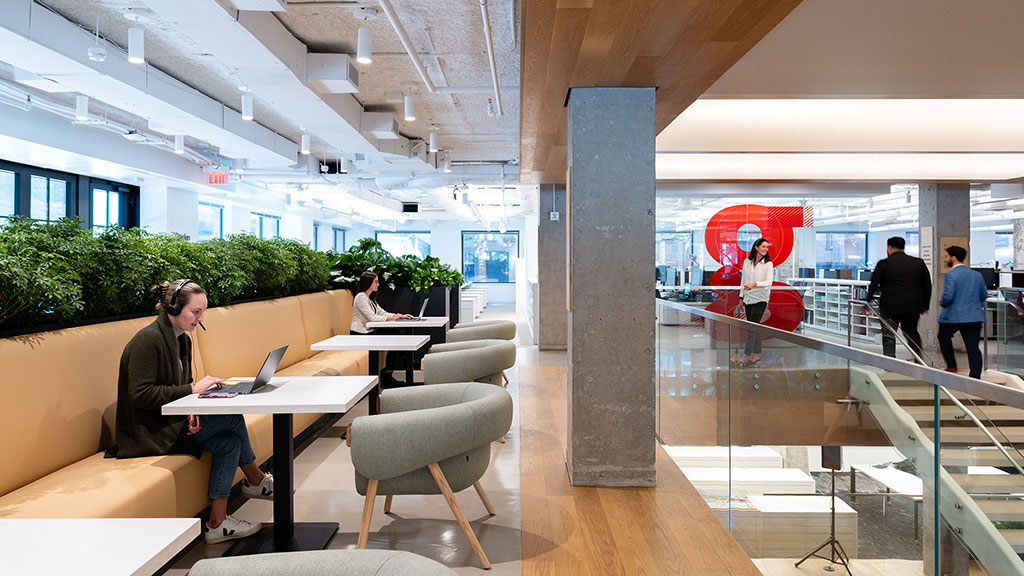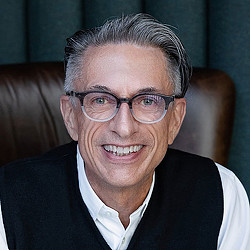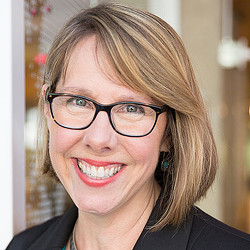10 Workplace Trends for 2024: What’s In and What’s Out?
December 20, 2023 | By Louis Schump, Janet Pogue McLaurin
Editor’s Note: This blog is part of our Design Forecast blog series, looking at what’s next in 2024 and beyond.
As more organizations understand that the workplace landscape has permanently changed, the focus will be less on how many people come into the office and more on how the office can support people’s needs. To evolve with changing demands and earn people’s commutes, the workplace will undergo several other key shifts: the focus will move away from real estate metrics to people performance; from one-size-fits-all to curated destinations; from virtual to in-person relationships; from open plans to degrees of openness; from static, monotonous office buildings to dynamic environments that prioritize choice and workers’ well-being.
Here are 10 emerging workplace trends to watch for in 2024:
In: People Performance | Out: Real Estate Metrics
Business performance is ultimately about people performance. The physical workplace must be effective for people to build community, grow talent, learn cultural norms, and create alignment. This requires spaces for people to work both solo and collectively to get work done. Gensler’s global workplace research shows that better designed, people-centric workplaces have significant return on investment for individuals, teams, and the business outcomes. OUT are the old ways of measuring success by real estate efficiency, density, occupancy, and butts in seats.
In: Curated Destination | Out: Universal Planning
The new workplace is compelling destination with a choice of experiences where people desire to be. Office workers want everything the office has traditionally offered (colleagues, technology, mentorship, socialization) and everything they have become used to at home (privacy, acoustic control, fresh air). The workplace will look and feel different for each company or site based on the mix of experiences, demographics, and functions at each location. OUT is the undifferentiated open-office with its one-size-fits-all programing template.
In: Abundance | Out: Musical Chairs
A little like learning to drive in an empty parking lot before tackling the freeway, navigating the new office with its social spaces, team spaces, unassigned desks, and deep-focus rooms takes some extra physical and emotional space to get used to. Having more work points than people can provide an opportunity to comfortably try things out while knowing there will always be a seat available. Abundance naturally allows new behaviors habits and mindsets to form. OUT is a real estate strategy based on scarcity, such as assigning 100 people to 80 desks, which can result in the fear of not getting a seat when in the office.

In: Pheromones | Out: Light Rings
Building relationships in-person just can’t be duplicated virtually. The richness of face-to-face communication is not just words, but also non-verbal cues, body language, subtle nuances, and even the unconscious exchange of pheromones, which are chemical signals that play a role in human attraction and bonding. Shared physical spaces that foster a sense of genuine connection, allowing people to build trust, empathy, and rapport are IN. OUT are days full of only virtual connections and Zoom meetings.
In: Multi | Out: Mono
Contrary to single-use areas, multi-use neighborhoods are thriving. Districts containing offices, residences, restaurants, and retail adjacent to mass-transit and parks continue to attract residents and businesses alike. IN is the vibrant 20-minute city where all of these amenities are within a 20-minute walk or bike ride of each other. OUT are the monotonous office buildings that act as singular biospheres in vast parking lots.
In: Biophilia | Out: Purell
Gardens, yards, and parks have all become desirable, if ergonomically challenged, workplaces. Light, fresh air, and being surrounded by living things helps us concentrate, be more creative, and healthful. In our new San Francisco office, the light, bright, plant-filled ‘Solarium’ is the most popular workplace destination. Likewise, in our Washington, D.C. office, a new ‘Garden District’ gives workers the ability to work in an indoors or outside garden. OUT are the stark, anti-septic workplaces where any living organism feels out of place.
In: Privacy | Out: Open
Privacy for uninterrupted focus work has never been a more important design consideration. Across the U.S. and globally, “to focus on my work” is the top-ranked reason to come into the office. Getting work done requires both working with others and working individually. This often cannot be compartmentalized by day of the week or by physical location — we toggle between these work modes constantly. Providing ‘degrees of openness’ ranging from enclosed focus rooms to libraries to quiet zones can better support new ways of working beyond the desk. OUT are seas of open plan desks as the primary place to focus on individual work.
In: Well-being | Out: Wellness
People want to work with and for companies that align with their personal values and care deeply about their people. Employee well-being goes beyond financial security or providing a gym. There is a shift to a more holistic approach to health by also providing spaces to connect, reflect, refresh, and recharge for mental and social well-being — making a positive impact on the individual, the local community, and the planet. OUT is fitness as a synonym for wellness.
In: Workplace Ecosystems | Out: Tenant Space
In this hybrid era, people no longer work in one place but instead prefer a variety of different work points — both in and out of the office. There is not only a “flight to quality” in terms of better buildings, but also a “flight to experience” for workplaces located in vibrant neighborhoods with restaurants, retail, residential, and parks to provide an array of different experiences. The workplace ecosystem extends beyond the walls of the office to provide coffee shops, libraries, and outdoor spaces as additional places for employees to work, meet, socialize, relax, and recharge. OUT are tenant spaces designed to prevent employees from interacting with their surroundings.
In: Joy of Work | Out: FOMO
Joy, and joy of work, is an important part of the human experience. Employees flourish in effective work environments that support their mind’s best work, but they also need a great work experience — one that captures their heart and soul. Simply getting lost in the joy of meaningful work can drive intrinsic motivation, sense of purpose, and satisfaction. Social connections, being part of a community, and having fun can contribute to higher employee engagement. OUT is showing up out of fear or mandates.
In: Keeping it Right | Out: Getting it Right
Work is dynamic. Workplaces must adapt as work changes and employee expectations evolve, yet only 38% of workplaces have been remodeled since the pandemic. The best workplaces will be designed for ever-evolving change, like retail environments, which are constantly updated. Piloting new ideas, testing design solutions, gathering data, adjusting for feedback, and always being in beta is in. OUT is the physical workplace that is treated as precious and remains static.
Workplaces are for people.
This is a time of incredible opportunity to rethink not only how people work, but what people need most to work at their personal and collective best. Resist the temptation for the status quo and embrace new thinking of what’s possible. Hybrid is here to stay, but so is the office. The workplace of the future can be a place where people want to be, where they feel part of a larger purpose and community, and where they feel cared for as a person. It’s time to put people first, foster the joy of work, and create a feeling of abundance in the workplace.
For media inquiries, email .


